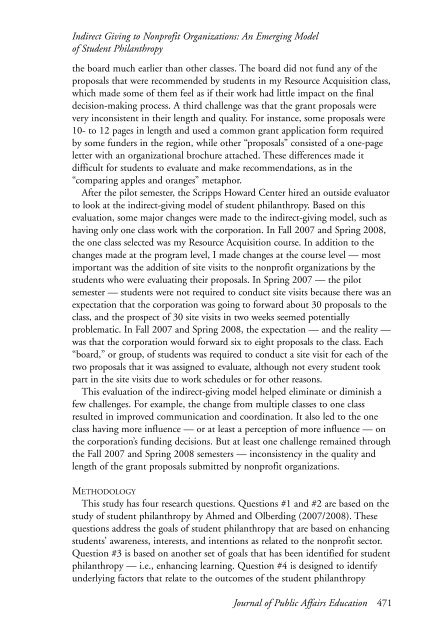JOURNAL OF PUBLIC AFFAIRS EDUCATION - National ...
JOURNAL OF PUBLIC AFFAIRS EDUCATION - National ...
JOURNAL OF PUBLIC AFFAIRS EDUCATION - National ...
Create successful ePaper yourself
Turn your PDF publications into a flip-book with our unique Google optimized e-Paper software.
Indirect Giving to Nonprofit Organizations: An Emerging Model<br />
of Student Philanthropy<br />
the board much earlier than other classes. The board did not fund any of the<br />
proposals that were recommended by students in my Resource Acquisition class,<br />
which made some of them feel as if their work had little impact on the final<br />
decision-making process. A third challenge was that the grant proposals were<br />
very inconsistent in their length and quality. For instance, some proposals were<br />
10- to 12 pages in length and used a common grant application form required<br />
by some funders in the region, while other “proposals” consisted of a one-page<br />
letter with an organizational brochure attached. These differences made it<br />
difficult for students to evaluate and make recommendations, as in the<br />
“comparing apples and oranges” metaphor.<br />
After the pilot semester, the Scripps Howard Center hired an outside evaluator<br />
to look at the indirect-giving model of student philanthropy. Based on this<br />
evaluation, some major changes were made to the indirect-giving model, such as<br />
having only one class work with the corporation. In Fall 2007 and Spring 2008,<br />
the one class selected was my Resource Acquisition course. In addition to the<br />
changes made at the program level, I made changes at the course level — most<br />
important was the addition of site visits to the nonprofit organizations by the<br />
students who were evaluating their proposals. In Spring 2007 — the pilot<br />
semester — students were not required to conduct site visits because there was an<br />
expectation that the corporation was going to forward about 30 proposals to the<br />
class, and the prospect of 30 site visits in two weeks seemed potentially<br />
problematic. In Fall 2007 and Spring 2008, the expectation — and the reality —<br />
was that the corporation would forward six to eight proposals to the class. Each<br />
“board,” or group, of students was required to conduct a site visit for each of the<br />
two proposals that it was assigned to evaluate, although not every student took<br />
part in the site visits due to work schedules or for other reasons.<br />
This evaluation of the indirect-giving model helped eliminate or diminish a<br />
few challenges. For example, the change from multiple classes to one class<br />
resulted in improved communication and coordination. It also led to the one<br />
class having more influence — or at least a perception of more influence — on<br />
the corporation’s funding decisions. But at least one challenge remained through<br />
the Fall 2007 and Spring 2008 semesters — inconsistency in the quality and<br />
length of the grant proposals submitted by nonprofit organizations.<br />
METHODOLOGY<br />
This study has four research questions. Questions #1 and #2 are based on the<br />
study of student philanthropy by Ahmed and Olberding (2007/2008). These<br />
questions address the goals of student philanthropy that are based on enhancing<br />
students’ awareness, interests, and intentions as related to the nonprofit sector.<br />
Question #3 is based on another set of goals that has been identified for student<br />
philanthropy — i.e., enhancing learning. Question #4 is designed to identify<br />
underlying factors that relate to the outcomes of the student philanthropy<br />
Journal of Public Affairs Education 471

















